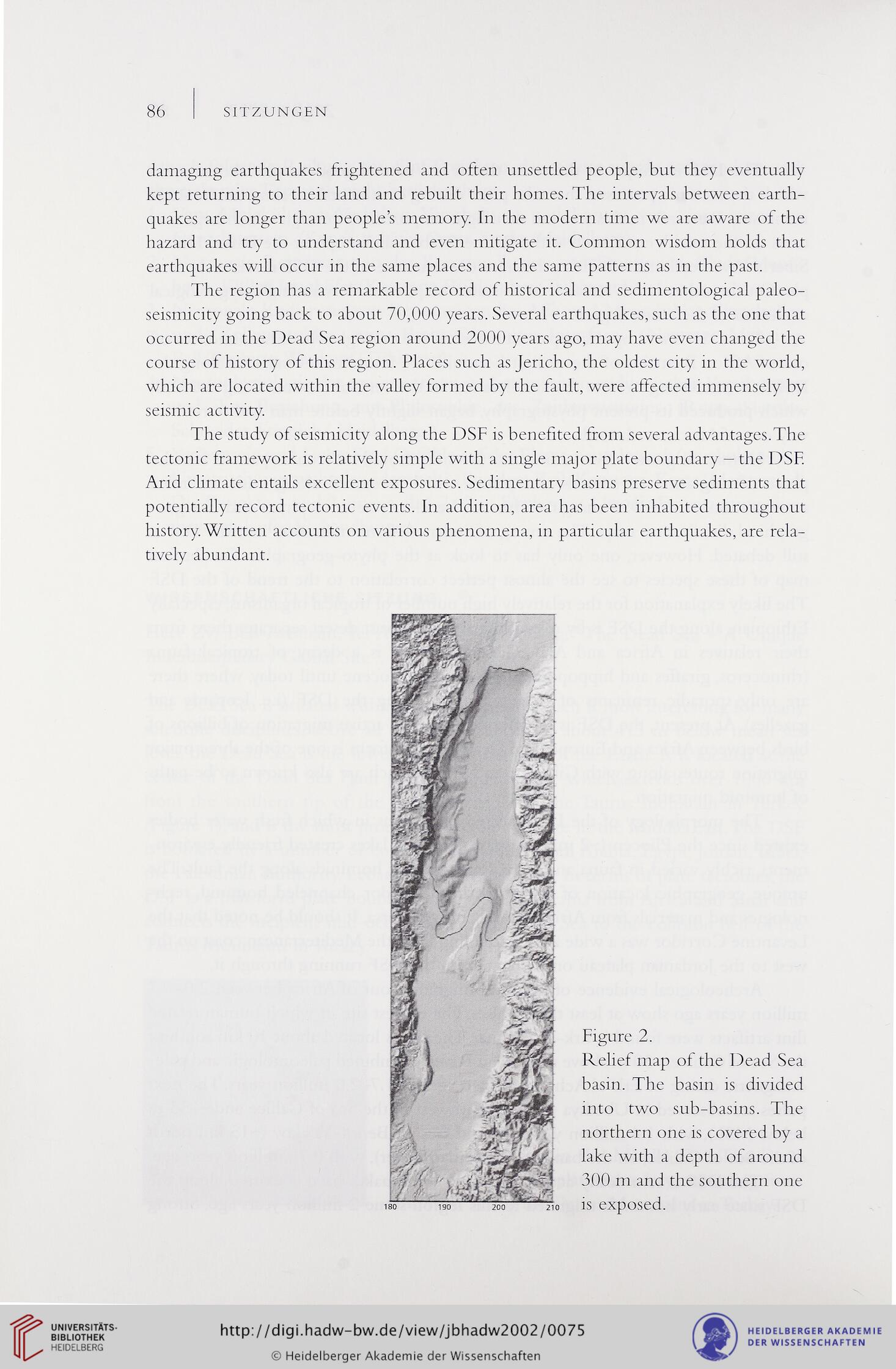Heidelberger Akademie der Wissenschaften [Hrsg.]
Jahrbuch ... / Heidelberger Akademie der Wissenschaften: Jahrbuch 2002
— 2003
Zitieren dieser Seite
Bitte zitieren Sie diese Seite, indem Sie folgende Adresse (URL)/folgende DOI benutzen:
https://doi.org/10.11588/diglit.66351#0075
DOI Kapitel:
I. Das Geschäftsjahr 2002
DOI Kapitel:Wissenschaftliche Sitzungen
DOI Kapitel:Sitzung der Math.-nat. Klasse am 29. Juni 2002
DOI Artikel:Ben-Avraham, Zvi: The Dead Sea - a unique interdisciplinary global site
DOI Seite / Zitierlink:https://doi.org/10.11588/diglit.66351#0075
- Schmutztitel
- Titelblatt
- 5-9 Inhaltsübersicht
- 10 Vorstand und Verwaltung der Akademie
- 11-27 Verzeichnis der Mitglieder der Heidelberger Akademie der Wissenschaften
- 28 Tabula mortuorum
- 28 Vertreter der Akademie in wissenschaftlichen Institutionen
- 28 Verein zur Förderung der Heidelberger Akademie der Wissenschaften
-
29-174
I. Das Geschäftsjahr 2002
- 29-50 Jahresfeier am 8. Juni 2002
-
51-105
Wissenschaftliche Sitzungen
-
51-54
Sitzung der Math.-nat. Klasse am 26. Januar 2002
-
55-58
Sitzung der Phil.-hist. Klasse am 8. Februar 2002
-
58-61
Gesamtsitzung am 9. Februar 2002
-
62-67
Sitzung der Math.-nat. Klasse am 27. April 2002
-
68-71
Sitzung der Phil.-hist. Klasse am 4. Mai 2002
-
71-77
Sitzung der Phil.-hist. Klasse am 7. Juni 2002
-
77-82
Gesamtsitzung am 15. Juni 2002
-
83-88
Sitzung der Math.-nat. Klasse am 29. Juni 2002
- 88-94 Gesamtsitzung am 13. Juli 2002
- 94-100 Sitzung der Phil.-hist. Klasse am 13. Juli 2001
-
100-101
Sitzung der Math.-nat. Klasse am 9. November 2002
-
101-103
Sitzung der Phil.-hist. Klasse am 30. November 2002
-
103-105
Gesamtsitzung am 14. Dezember 2002
-
51-54
Sitzung der Math.-nat. Klasse am 26. Januar 2002
- 106-110 Öffentliche Veranstaltungen
-
111-141
Antrittsreden
-
143-174
Nachrufe
-
175-245
II. Die Forschungsvorhaben
- 175-177 Verzeichnis der Forschungsvorhaben und der Arbeitsstellenleiter
- 178 Berichte über die Tätigkeit der Forschungsvorhaben
-
179-245
Die Forschungsvorhaben der Heidelberger Akademie der Wissenschaften
- 179-181 Interakademische Vorhaben
-
181-209
Mathematisch-naturwissenschaftliche Klasse
- 181-187 3. Archäometrie
- 187-194 4. Radiometrische Altersbestimmung von Wasser und Sedimenten
- 194-200 5. Weltkarte der tektonischen Spannungen
- 200-204 6. Anwendung der In-situ-Infrarotspektroskopie zur Minderung von Schadstoffemissionen
- 204-207 7. Mathematische Logik (Kaiserslautern)
- 208-209 8. Mathematische Kommission. Zentralblatt MATH
-
209-244
Philosophisch-historische Klasse
- 209-210 9. Deutsches Rechtswörterbuch
- 210-212 10. Altfranzösisches etymologisches Wörterbuch/DEAF
- 212-213 11. Altgaskognisches und Altokzitanisches Wörterbuch/DAG/DAO
- 213-215 12. Spanisches Wörterbuch des Mittelalters/DEM
- 216-221 13. Cusanus-Edition
- 222-223 14. Melanchthon-Briefwechsel
- 223-226 15. Martin Bucers Deutsche Schriften
- 226-227 16. Reuchlin-Briefwechsel (Pforzheim)
- 227-228 17. Luther-Register (Tübingen)
- 228-229 18. Evangelische Kirchenordnungen des 16. Jahrhunderts
- 229-231 19. Epigraphische Datenbank
- 231-233 20. Papyrus-Edition
- 233-234 21. Année Philologique
- 234-235 22. Internationale Kommission für die Erforschung der Vorgeschichte des Balkans
- 235-236 23. Heidelberger Antikensammlung
- 236-238 24. Lexikon der antiken Kulte und Riten (Heidelberg/Würzburg)
- 238-240 25. Felsbilder und Inschriften am Karakorum-Highway
- 241-243 26. Geschichte der Mannheimer Hofkapelle im 18. Jahrhundert
- 244 27. Geschichte der Universität Heidelberg
- 245 Von der Heidelberger Akademie wissenschaftlich betreute, aber anderweitig finanzierte Vorhaben
- 246-264 III. Förderung der wissenschaftlichen Nachwuchses: Das WIN-Kolleg
- 265 IV. Gesamthaushalt 2002 der Heidelberger Akademie der Wissenschaften
- 266-267 Publikationen der Heidelberger Akademie der Wissenschaften vom 1. 5. 2002 bis zum 28. 2. 2003
- 268-275 Personenregister
- Maßstab/Farbkeil
86 | SITZUNGEN
damaging earthquakes frightened and often unsettled people, but they eventually
kept returning to their land and rebuilt their homes. The intervals between earth-
quakes are longer than people’s memory. In the modern time we are aware of the
hazard and try to understand and even mitigate lt. Common wisdom holds that
earthquakes will occur in the same places and the same patterns as in the past.
The region has a remarkable record of historical and sedimentological paleo-
seismicity going back to about 70,000 years. Several earthquakes, such as the one that
occurred in the Dead Sea region around 2000 years ago, may have even changed the
course of history of this region. Places such as Jericho, the oldest city in the world,
which are located within the valley formed by the fault, were affected immensely by
seismic activity.
The study ofseismicity along the DSF is benefited from several advantages.The
tectomc framework is relatively simple with a single major plate boundary — the DSF.
Arid climate entails excellent exposures. Sedimentary basins preserve Sediments that
potentially record tectonic events. In addition, area has been inhabited throughout
history. Written accounts on vanous phenomena, in particular earthquakes, are rela-
tively abundant.
180 190 200 210
Figure 2.
Relief map of the Dead Sea
basin. The basin is divided
into two sub-basins. The
northern one is covered by a
lake with a depth of around
300 m and the Southern one
is exposed.
damaging earthquakes frightened and often unsettled people, but they eventually
kept returning to their land and rebuilt their homes. The intervals between earth-
quakes are longer than people’s memory. In the modern time we are aware of the
hazard and try to understand and even mitigate lt. Common wisdom holds that
earthquakes will occur in the same places and the same patterns as in the past.
The region has a remarkable record of historical and sedimentological paleo-
seismicity going back to about 70,000 years. Several earthquakes, such as the one that
occurred in the Dead Sea region around 2000 years ago, may have even changed the
course of history of this region. Places such as Jericho, the oldest city in the world,
which are located within the valley formed by the fault, were affected immensely by
seismic activity.
The study ofseismicity along the DSF is benefited from several advantages.The
tectomc framework is relatively simple with a single major plate boundary — the DSF.
Arid climate entails excellent exposures. Sedimentary basins preserve Sediments that
potentially record tectonic events. In addition, area has been inhabited throughout
history. Written accounts on vanous phenomena, in particular earthquakes, are rela-
tively abundant.
180 190 200 210
Figure 2.
Relief map of the Dead Sea
basin. The basin is divided
into two sub-basins. The
northern one is covered by a
lake with a depth of around
300 m and the Southern one
is exposed.




